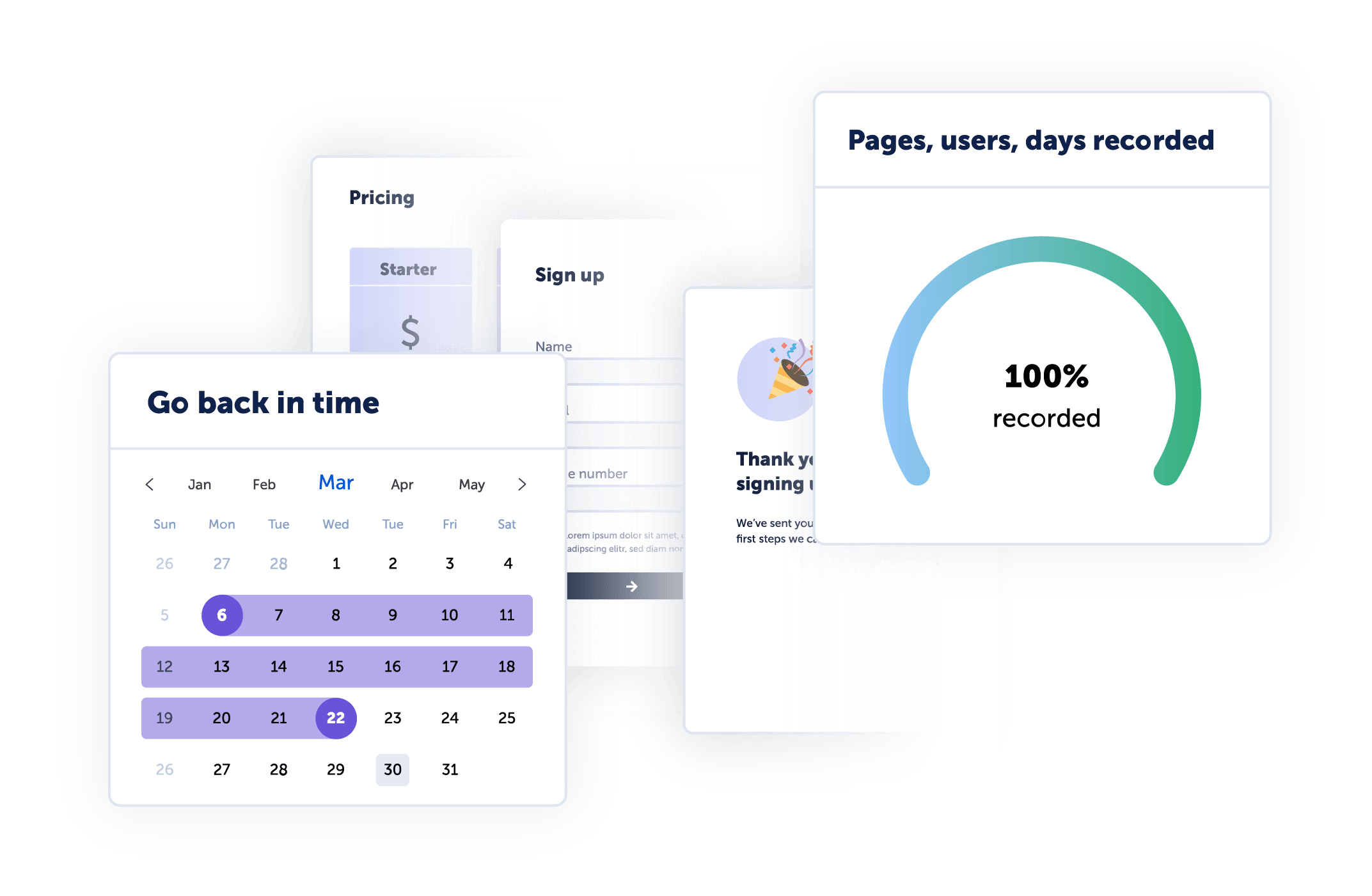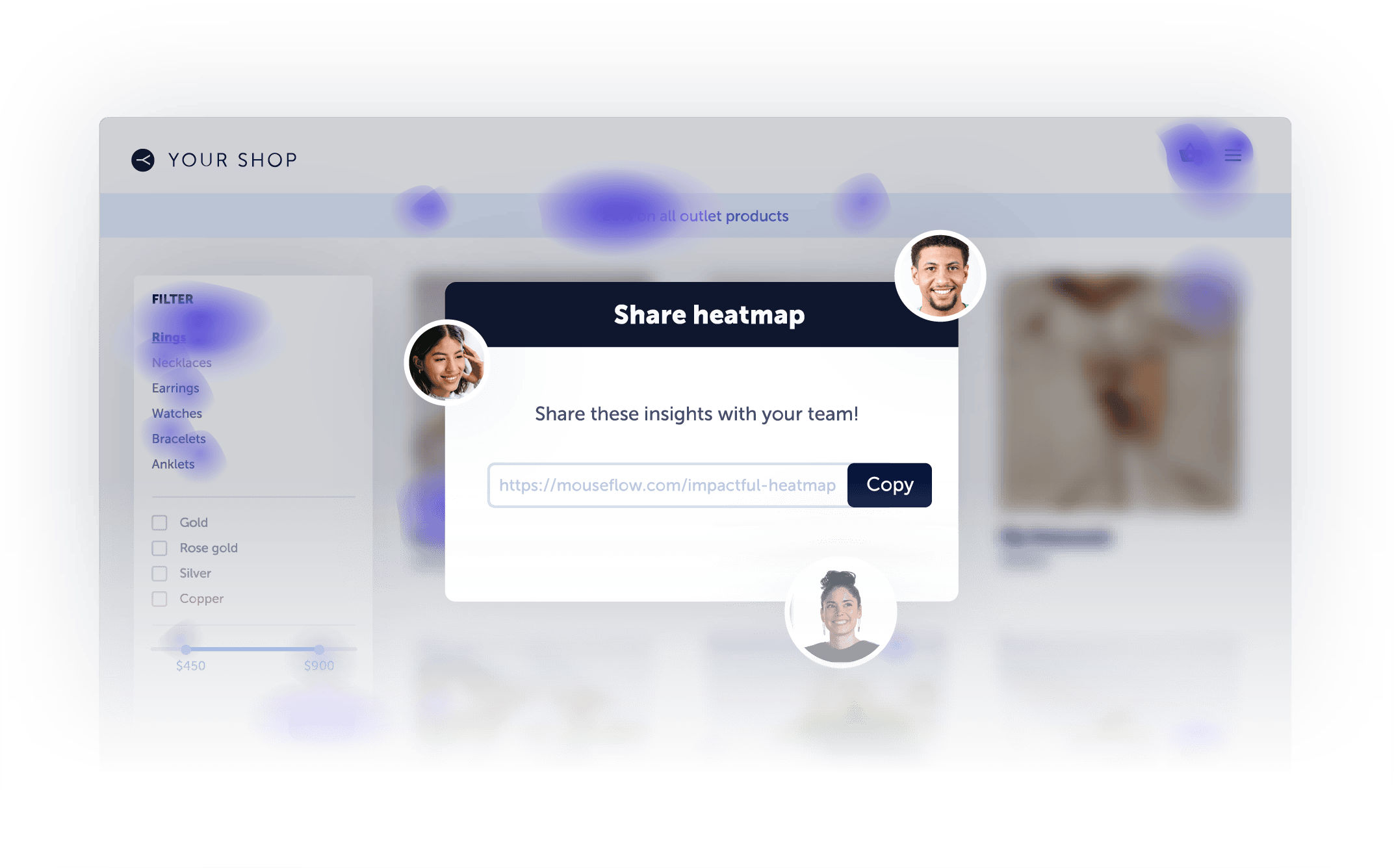
Record 100% of users and pages from day 1
Don’t wait for results — see the heatmaps you need without having to predict the future.
Mouseflow’s website heatmap tool records 100% of your traffic by default, instead of sampling only a fraction of it, like others do.
Plus, it records every page — so you can retroactively analyze user behavior (for 3-12 months) without the need for manual setup.
6 website heatmap tools in 1
Click, scroll, attention, movement, geo, live.
How far do users scroll? Which content actually aids conversions? What distracts from the journey? Where is my user base located? How do they interact with dynamic menus, iframes, and elements?
Welcome to the next generation of website heatmap software, a full suite of user behavior data visualizations.

Friction score for easy heatmap analytics
Pinpoint the heatmaps and users you need, instantly.
Thousands of users, hundreds of pages, months of data — where do you start? With your website heatmap tool’s Friction Score.
Rely on automatic Friction Scores to call out the least satisfied users. Then, dive in and analyze the heatmaps with the most impact.

Conversion-driving data to optimize with confidence
Don’t guess — backup your actions with visualized data.
Easily share heatmaps and session recordings with stakeholders to add visual context to your recommendations.
Assure your team and empower collaboration, right from your heatmap tool.
Questions you can answer with the use of heatmaps
Adjust your design to fit your visitors’ navigation style and lead them to success quicker.
Remove content, CTAs and design elements that are not generating interest to help them focus on what matters.
Uncover intent beyond clicks by analyzing how long it takes them to interact with your CTAs.
Check what non-interactive elements are getting clicks on your page and serve them content that matches their intent.
Find out what content performs best and adjust placement to serve conversion-driving content first.
Geographical location, traffic sources, devices, operating systems among others play an important role on engagement. Find nuances to adjust your design and content to serve your visitors better.
Get more context from your A/B tests by analyzing each variant heat map.
Frequently asked questions
A heatmap is a data visualization that spawned from the simple color-coding of data matrices. By assigning values to colors along a scale of cool/warm (think back to art class — blue is cool, red is warm), they can represent areas of high or low measurements. Common Hollywood examples tend to come in the form of heat-seeking missiles or infrared thermal cameras. Heatmaps are also used by geologists, statisticians, geographers, climate scientists, civil engineers, biologists, meteorologists… The list goes on.
A website heatmap is primarily used by marketers, analysts, UX specialists, product specialists, conversion optimization specialists, and others focused on measuring and improving online user experiences. It visualizes user data — such as clicks, scrolls, movements, and more — as heat signatures. “Hot” spots represent high activity, while “cool” spots show low or no activity.
Website heatmap tools provide this data to enable teams to confidently identify areas of opportunity or challenge in their customers’ or users’ journeys. Using a website heatmap tool empowers optimizations to content, messaging, design, and more to deliver better experiences and business ROI from a website.
For a thorough explanation, check out guide to heatmaps.
Website heatmap tools work behind the scenes to anonymously track users on your websites — where they click, scroll, navigate, hover, etc. To create one for your website, simply sign up for Mouseflow, install the tracking code on your website in a couple clicks, click one more time to start recording, and voila — you’ll begin collecting website heatmap data.
Get started with our free website heatmap tool that scales as your business grows.
Click heatmaps tell you where on your web pages your users click their mouse, hover their cursor, or otherwise interact with your page with their mouse or trackpad, or their finger taps if on mobile. One way (of many) it’s useful is to help understand what users want to click in relation to what you intend for them to click, then rectifying the misalignment to improve conversions.
Scroll heatmaps look at how deep users scroll down the page. It tells you a percentage of users that make it to or past a certain point. It’s useful in informing which content should be placed above the fold, for instance, to drive more purchases, sign-ups, clicks, etc.
Attention heatmaps combine click and scroll data to visualize high- and low-interaction sections of your site. If you’re trying to decide where to place a new CTA button, an attention heatmap can help you understand where it will get the most visibility and the highest likelihood of a click.
Movement heatmaps are similar to click heatmaps, except they track mouse position, not just its click point. So, it can help you understand where users may be searching for what they want, leading you to optimal placement.
Geo heatmaps are actually maps of Earth, not your web page. Instead of on-site user behavior measurement, geo heatmaps provide anonymized location data that gives insight into where your web visitors live geographically. One way to use this info is to better target regional PPC campaigns towards high-converting geographic audiences.
Live heatmaps provide an interactive way to visualize heatmap data, allowing Mouseflow users to engage with dynamic elements — menus, sliders, etc. — and understand their multi-layer click data. Go beyond standard, static heatmaps to visualize behavior data as you navigate your site live.
For more information on heatmaps, check out our Heatmaps Guide.
Mouseflow’s recent accolades include:
G2 (Spring 2024): Leader, Momentum Leader, Fastest Implementation, Most Implementable, Best Usability, Best Results, and Best Relationship.
Capterra Shortlist for Web Analytics Software 2024
GetApp 2024: Category Leader in Web Analytics, Heatmaps, and Website Optimization Tools
We’ll let you decide — check out real user reviews on GetApp, G2, and Capterra and look at similar tools side-by-side with our handy comparisons to tools like Hotjar, CrazyEgg, FullStory, Contentsquare, VWO, lucky Orange, and more.
Website heatmap software can lead to optimizations that increase conversions, conversion rate, lead quality, order value, and more — all by visualizing how actual users interact with your website. For example…
Marketers use heatmaps to find out which messaging, calls-to-action, imagery, and design best leads to conversion. They also use it to understand differences between audiences, such as paid social versus organic search. To give you an example, here’s how to use Mouseflow heatmaps for WordPress.
Analysts turn to website heatmap tools to help them answer — and ask — questions about user behavior. When the data raises a red flag, analysts can dive into heatmaps of specific sessions (individual or cohort) to understand and propose solutions for obstacles faced by those users.
Product managers leverage website heatmaps to help prioritize feature upgrades, bug fixes, and other operational decisions. Heatmaps can highlight reasons for slow user adoption, identify outliers vs trends, and measure user reactions to product changes.
UX specialists might deploy website heatmap tools to add visual context to their hypothesis, such as why they chose a certain experience design. They’ll also use heatmaps to catch bugs earlier, complement user testing, and maximize user satisfaction, retention, and upgrade.
CRO (conversion rate optimization) specialists love heatmaps for their ability to help “sell” a hypothesis or test plan to stakeholders, while reducing risk. Website heatmaps can also visualize the impact of certain changes to help attribute revenue or conversion lifts. And when session count is too low to run experiments, heatmaps are a great CRO tool for low website traffic.
Website heatmap software is also beloved by other teams: sales, web development, business intelligence, engineering, and more. Learn more about the advantages of using heatmaps.
A website heatmap tool like Mouseflow’s fits best when used in concert with other web analytics features, such as session recording, funnel analysis, form optimization, and user feedback. Mouseflow’s value can also be maximized by integrating it and using it in concert with web traffic analytics tools such as Google Analytics (we have an integration with GA4) or Adobe Analytics (we have an integration with Adobe Analytics too).
Whole other web analytics tools can tell you about traffic sources and performance, you need a website heatmap software like Mouseflow to truly understand users’ on-site behavior.
Luckily, Mouseflow boasts dozens of analytics integrations to make install, setup, and collaboration a breeze.